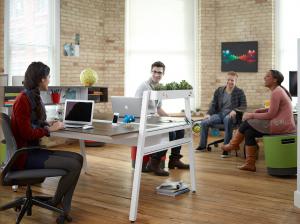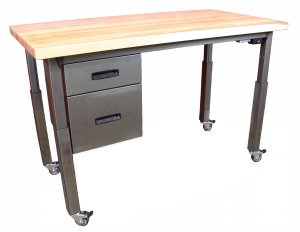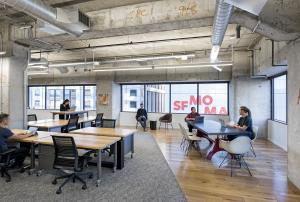Increase Employee Engagement with Influential Office Design
If you want to improve employee engagement, you need to understand 4 key aspects of the modern office. Check if your office meets the criteria!
Sounds reasonable, but ‘how’ to go about it is the question.
Do you put up motivational posters? Create an incentive program? Invest in sending workers to employee motivation workshops?
It turns out the answer may be closer to home.
You may not realize it, but creating the right office environment has a tremendous effect on whether your employees are healthy, happy, motivated and engaged in their work or not.
If you want to improve employee engagement, you need to understand four key aspects of the modern office which influence the performance of your employees:
Promoting physical health and well-being for employees in their workspaces.
Understanding the effect of critical environmental cues in the office.
Leveraging advances in information technology to create new choices for employee workspaces.
Using office design to influence the way employees, customers and prospects view your company.
Promoting physical health and well-being for employees in their workspaces.
According to Professor Sean Mackey MD of the Stanford University Medical Center, lower back pain affects more than 100 million Americans and results in approximately $600 billion a year in medical expenses plus countless hours off the job for treatment. And lower back pain is just part of the problem. Your employees can also run the risk of repetitive stress injuries and other associated injuries on the job. That’s why it’s so important to start with the basics and provide your employees with comfortable, ergonomically correct seating and worktables.
Make sure your employees have a comfortable, ergonomic place to work
As we all know, employees come in all shapes and sizes. This makes it even more challenging to find the right ergonomic seating arrangement for each individual.
Adjustable chairs have been an accepted part of the office design landscape for many years. Now electrically-operated tables and computer workstations that can be height adjusted at the touch of a button are becoming standard equipment in modern offices.
These so-called “Sit-to-Stand” workstations allow employees to change their seating position throughout the day, moving from a seated position to a standing position at the touch of a button.
Not only do these flexible tables and workstations make it easier to accommodate employees of different statures, they can also help significantly improve employee health. Researchers like David Alter, MD, PhD, Senior Scientist at the Toronto Rehabilitation Institute-University Health Network and Institute for Clinical Evaluative Sciences have published studies that indicate:
Staying seated for prolonged periods of time can increase the risk for heart disease, diabetes, cancer and death– regardless of whether the person exercises regularly are not. Even exercising an hour or more a day doesn’t eliminate the health risk that comes from regular prolonged sitting.
Make sure employees move during the day with sit-to-stand desks
More and more health professionals describe this phenomenon as “Sitting is the new Smoking” – in other words a sedentary lifestyle can be as bad for you as smoking cigarettes. An investment in Sit-to-Stand desk furniture can help improve your employees’ long-term health and increase their effectiveness on the job.
Understanding the effect of critical environmental cues in the office.
Natural lighting has a major effect on employee engagement and productivity.
If you are relying on artificial light, be cautious. Millions of iPhone users have become aware of the unintended effects that artificial lighting has on our physiology – such as when we try to stay awake or go to sleep. Apple’s recently introduced Night Shift feature addresses the latter, by changing the screen to a warmer color palette during the late-night hours to help promote sleep.
This illustrates the importance of natural light as a critical environmental cue. As Psychology Today reports, exposure to natural light improves workplace performance, so when you are considering how to do your office space layout try to maximize natural light streaming into the workspace.
Don’t overlook other environmental cues that improve employee happiness and productivity. A recent study published by Dr. Chris Knight from Exeter University concludes that overly austere office spaces can be too Spartan for our own good.
In the 18 month project, Dr. Knight and the other psychologists determined that worker productivity increased by 15% by adding just a few houseplants to an otherwise spare office environment.
Employee performance on tests like memory retention improved when they could see a plant from their desk.
The study co-author Prof Alex Haslam, from the University of Queensland’s School of Psychology, said “Our research questions this widespread conviction that less is more. Sometimes less is just less.”
Leveraging advances in information technology to create new choices for employee workspaces.
Employees who primarily work with information, the so-called “knowledge workers”, have many more options for working on the go — thanks to smartphones, tablets and lightweight notebook computers connected to the Internet. As a result, fewer and fewer workers are actually sitting at their desks. According to a 2009 study by the GSA, only 30 to 40% of workers use
Read more... https://formaspace.com/articles/architect/increase-employee-engagement-influential-office-design/?utm_source=einpresswire&utm_medium=content&utm_campaign=article-052416
Mehmet Atesoglu
Formaspace
8002511505
email us here
Legal Disclaimer:
EIN Presswire provides this news content "as is" without warranty of any kind. We do not accept any responsibility or liability for the accuracy, content, images, videos, licenses, completeness, legality, or reliability of the information contained in this article. If you have any complaints or copyright issues related to this article, kindly contact the author above.




